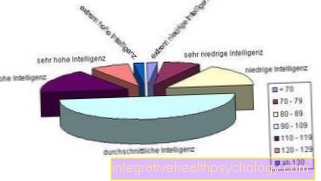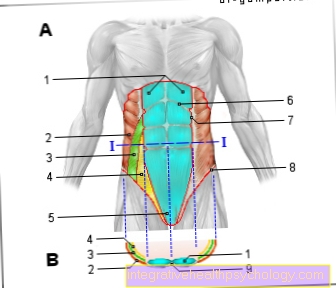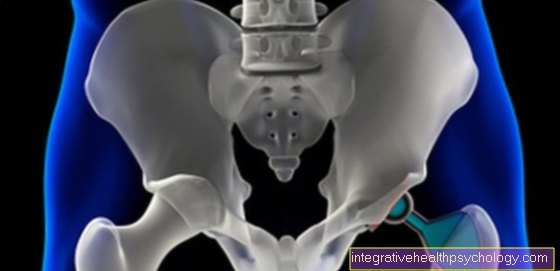Differential learning
introduction
The classic idea of learning a movement is normally as follows: The practitioner repeats the movement to be learned several times in a row. At the beginning, the movement is usually carried out very unsafe and technically unclean. The teacher or trainer has a certain idea of what the target movement should look like and tries to do this using series of images (visually) or descriptive (acoustically) to convey to the trainee as clearly as possible. Everything that deviates from this optimal target movement (technical model) during the execution of the movement is wrong and must be avoided as far as possible during the repetition of the practitioner (constant target / actual value comparison). The deviation from the technology model is increasingly reduced until the target movement is reached with as little fluctuation as possible.
Everyone knows this procedure from physical education or training in a club. The trainer tries to repeat the movement and to correct the mistakes until the target movement (target technique) is achieved. Anyone who is not particularly involved in sport can make this connection clear with traditional school lessons. If a mistake was made in the dictation earlier, this word had to be repeated several times. In this context it becomes clear that the focus is on intervening and imagining the optimal movement of the trainer / teacher. If a word were misspelled repeatedly while correcting a dictation, the wrong word would be memorized. This can be seen in a similar way in sport.
Also read our article: Learning theories.
In this case, the athlete / student is viewed as a “technical deficiency” who has no “movement” experience. In this so-called program-theoretical procedure, human learning is understood as a kind of computer.
Now, however, there is a problem with this view of learning, both in the motor and cognitive areas, because the human brain (and therefore learning) does not work like a computer. The brain works best with associations of the known. However, this ability is neither (or hardly) used in school nor in extracurricular sports / learning.
In differential learning it is assumed that the person himself has the ability to learn the correct movement etc. Often this approach is not accepted or not yet accepted in training practice due to a lack of understanding. Many coaches are of the opinion that if the athlete develops the right movement himself, the coach figure becomes superfluous. This is by no means the case, rather the other way round, the trainer has to face more and more difficult tasks. (More on that later)
At this point, it must be pointed out that conventional training (program theory perspective) is not wrong or bad compared to differential learning, it is based on a different principle and ultimately leads to success. However, results from more recent studies have shown that learning through differential learning has achieved faster results.
First an example
A classic example of the system dynamic approach (differential learning) in motor learning can be found in small children learning to walk. Until the target movement is learned (upright walking) the learning process is characterized by very high fluctuations in the execution of movements. Learning takes place exclusively through independent experimentation. Parents rarely break down walking into partial movements and teach toddlers using compounding partial methods. However, the target movement is always achieved in near perfection. The child experiences a very great sense of movement due to the high fluctuations in learning to move.
approach
Differential learning assumes that movements, no matter what sport, a very high level of individual factors includes. This can be seen very well using the example of technology in tennis of the two athletes (Roger Federer and Raphael Nadal) detect. Both games at the highest level with completely different techniques. A technology model is therefore very difficult to determine, since every person has different dispositions to solve a movement task.
The differential approach thus represents technology models in movement learning in question. Another factor from the system dynamics approach (differential learning) is the movement always are exposed to high fluctuations. It is practically impossible to do the same Blow/ shot/ Litter etc. to be carried out twice under the same conditions, since too many external and internal factors disturb the movement. It is precisely these fluctuations (referred to as errors in the program-theoretical approach) that differential learning uses to enable the largest possible range of movements. As with the program theoretical approach, it is about achieving the individual optimal target movement, but with differential learning the human being is understood as a self-learning system.
Notice
If a sporting movement is subject to external (opponent, wind, etc.) and internal (muscles, joint positions, etc.) influences, the movement will always be characterized by fluctuations. These fluctuations can / must be integrated into the training process. Another example of the exploitation of the fluctuations is the fact that children who attended children's gymnastics at an early age have greater success in sports than children without this experience. Gymnastics in the early years opens up a wide range of movement experience and better body awareness.
Man strives for variation
Man strives for differences. Both on the physiological and on the neurological side. This also applies to a Strength training. Doing the same workout with the same weights and repetitions is unlikely to produce the desired results in the long run. Anyone who has worked in hypertrophy (Muscle building) trained, will achieve greater success in muscle building with a single training stimulus in the strength endurance area than another hypertrophy stimulus.
implementation
Lots (this does not imply all) However, trainers do not understand the intention of this approach and misinterpret the fluctuations mentioned. It goes without saying that the right amount of movement variation is important. These differences, also known as "Noise" must be chosen by the trainer in such a way that a reference to optimal movement is always guaranteed. For example, consider the Service in tennis. Differential learning includes a changed environmental condition (Choice of club, choice of ball) and changed technical components (Foot position, hip insert, arm insert, grip position etc. etc.). Typical errors well known to the trainer are deliberately integrated into the execution of the movement in order to enable the adaptation in the neural network (neural plasticity) to provoke. However, the focus and choice of swaying must always provoke the achievement of the target movement. It is therefore not beneficial to simulate an impact from below, as this is very far from the target movement (impact from above) in terms of the extent of movement. In the ideal case, so-called noise is consciously used in every movement.
Attempt to explain this approach from a sports science perspective
Will movement learning through differential learning varies around the respective target movement, enables the learner to react variably in future movement sequences. It comes to Interpolarization of the technique. Let's consider the example of tennis:
In free play, the player has to react to a constantly changing movement situation through the influence of the opponent. The fluctuations in movement learning give the athlete greater freedom of movement and action. The target movement is not linked to the technical model of the trainer, but develops in the course of development for each player himself. We speak of a solution area.
proof
The proof of differential learning has been carried out several times in practical studies. The classic approach (program-theoretical perspective / methodical exercise series) and differential learning were compared. In the areas of basketball, soccer, tennis and the shot put, significant improvements in performance have already been observed.
Differential learning in handballintroduction

The rule change in the 90 years led to fundamental changes in the Handball game. This structural change made a much faster game pace and more dynamism possible. The performance requirement or the conditional requirement profile has been moving more and more into the foreground since then. Elementary for the sport of handball is next to the tactics and condition, learning the right one technology and therefore also the right technique training. When learning a technique, a distinction is made between two different methods:
- Program theory (more traditional) APPROACH
- System dynamic (differential) APPROACH
The program theoretical approach
The so-called conservative program theoretical Approach comes from classical psychology and sees people learning movements as a pure information processing system. So-called generalized motor programs (gmP) arise. A newly learned movement is thus a new centrally stored program. This learning method is characterized by a high number of repetitions in the same situation. In tennis, this would be repeating the same stroke over and over again.
Rough coordination --> Fine coordination --> Fine coordination
Classic mediation methods are
- Methodical principles
- Methodical exercise series
- Methodical game series
Criticism of the program theoretical approach:
A number of problems arise with the program theory approach, which are briefly summarized below. The control and correction is always externally controlled by the teacher or trainer. There is no evidence of a central control system in the brain on which the program theoretical approach is based. The natural fluctuation within the movement is always given, even in high-performance sport.
More on the topic at: Motor learning
The system dynamic approach
Basis for the system dynamic, differential The approach is physics. This approach sees humans as a synergetic, non-linear, chaotic system that self-organizing learns. Movement learning takes place here as a search process and an experience process of perception and experience. Compared to the theoretical program approach, there is no standardized movement sequence here.
Variability -> instability -> self-organization
Differential learning approach
The Execution variability is consciously used and applied in differential learning in order to minimize fluctuations within the Move to provoke. This triggers the process of self-organization. Note: Small children learn to walk in the differential system. At the differential learning different possibilities arise to consciously create a variability within a movement.
- Differences in the spatial Movement execution
- differences in spatio-temporal Movement execution (speed)
- Differences in the dynamic Movement execution (acceleration)
- Differences in the temporal Movement execution (rhythm)
Note:
If we look at the large joints in the human body, we count 14. Combined with the above-mentioned execution options, there are an infinite number of combinations of movements.
Difference between program-theoretical and system-dynamic learning:
- In the program theoretical approach, the program is the basis for movement learning. In differential learning, this develops in a self-organizing manner.
- Errors are avoided in the program theoretical approach and corrected until there are no more errors. In differential learning, however, errors are consciously implemented and used.
- The program theory approach works with many repetitions, while differential learning does not make any mistakes.
- The program theory approach is characterized by little difference, which is fundamental in differential learning.
- Successive adaptation against adaptation by using the entire range of variation.
- Linear arrangement versus non-linear arrangement of the methodical forms.
Possible variations in the practical implementation in handball
- Different throwing positions (over head, head high, waist high, knee high ...)
- Different throwing devices (large ball, small ball, heavy, light ball ...)
- Different ball acceptance (front, back, side, head high, knee high ...)
- Different speeds (slow, fast, submaximal)
- Different joint positions (max. Bent, stretched, middle position)
- Different position of the upper body
- Different muscle tension
- Different status
- Different foot position
- Different number of steps
Here you can see very well that alone when Throw and catch so many possible variations. It is recommended not to exceed more than 60 litters at 2 to 3 Perform workouts per week. The complexity should always be increased in the course of the training.
Conclusion
Numerous studies have already shown that better training results can be achieved with a system dynamic approach than with conservative training. However, the question arises why almost all sports and associations work almost exclusively with the program-theoretical approach.





























